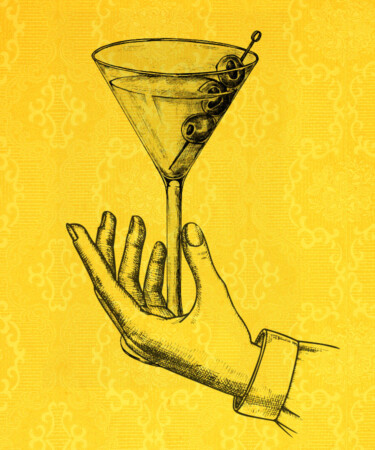We’ll likely never know exactly who invented the Martini, but there are a few bits of history that provide a general timeframe of when the drink came to be. In 1884, O.H. Byron published “The Modern Bartenders’ Guide,” which lists the Martinez as a gin-based Manhattan riff. Four years later, the second edition of Harry Johnson’s “Bartender’s Manual” included the first-ever written mention of a “Martini Cocktail.” On page 38, Johnson provides a Martini recipe consisting of several dashes of gum syrup, Boker’s Bitters, and Curaçao with equal parts Old Tom gin and vermouth, and garnished with a lemon twist.
Over the following 20-plus years, numerous drink recipes that went by a handful of names, like Martini, Marguerite, and Crisp Cocktail were printed — all of which adhere somewhat to the modern Martini spec. Nowadays, a Martini is typically defined as a blend of either gin or vodka and dry vermouth with either an olive or lemon twist for garnish. Some “Martinis” today don’t even contain vermouth, resulting in a straight-up swimming pool of cold booze.
However, if we consider the two core ingredients of gin and vermouth, there’s evidence that suggests that the world had the means to make Martinis all the way back in the 1600s. Of course, the same could be said for numerous drinks, as lime juice, sugar, and rum coexisted for centuries before the Daiquiri was formally popularized. In the case of the Martini, though, drinkers in England were literally drinking gin and an early iteration of vermouth in the same sitting. If only they decided to mix the two together.
Purl and Purl-Royal
In the 1600 and 1700s, people would often drink alcohol in some capacity from dusk till dawn — especially in England — due to the fact that it was generally safer than water. As such, hangovers and drinks touted as hangover cures were popular. One such concoction was Purl.
According to drinks historian David Wondrich’s 2007 book “Imbibe!,” “Purl has come down to us as a Dickensian mixture of hot ale, gin, sugar, and eggs, with nutmeg on top. But in the seventeenth century, it was something rather different: A sharply bitter ale infused with wormwood and other botanicals and drunk in the morning to settle the stomach, if settling was needed.”
In its heyday, Purl had a slightly boozier sibling known as “Purl-Royal.” This was essentially the same drink, but instead of bitter ale, its base ingredient was sack, a sweet sherry fortified with brandy. As Wondrich writes, “If you were to taste Purl-Royal today, you’d have no trouble at all classifying it: vermouth.”
Sweet and dry vermouth as we know them today weren’t invented until the late 1700s and early 1800s, respectively, so Purl-Royal was a sort of vermouth prototype. In fact, vermouth originally got its name from “vermut,” the German word for “wormwood,” which was a key ingredient in Purl-Royal.
A Martini, Divided
Purl was famously enjoyed by British writer and Tory politician Samuel Pepys. Pepys is best known for a diary he kept from 1660 to 1669 in which he details his day-to-day life, including personal affairs, political and social happenings, and what he drank.
“Purl-Royal was another thing Pepys drank. He also drank gin,” Wondrich writes. “Interestingly enough, Pepys drank vermouth and gin in the same year, 1663, with the same person, Sir William Batten.”
While elaborate mixed alcoholic drinks in the form of “punches” existed in Europe during Pepy’s lifetime, mixology — let alone Martinis — had yet to be realized by the general drinking public. Thus, although Pepys and Batten were drinking gin and pseudo vermouth together, they never combined the two drinks in the same glass.
By 1690, London-based apothecary owner Richard Stoughton introduced “Stoughton’s Great Cordial Elixir,” which was essentially the first patented bitters — gentian included. Like Purl-Royal, Soughton’s Elixir was touted as a hangover cure. People started adding the stuff in small doses to their morning cup of Purl and, later on, drams of brandy, marking the early genesis of the modern cocktail. While gin’s popularity continued to rise in England, it would be another near-200 years before the Martini entered the zeitgeist.
So why didn’t Pepys mix Purl-Royal with gin? It’s likely that the idea just never occurred to him. “Had [Pepys] thought to mix them, the Age of Reason might have been rather different,” Wondrich writes. “Imagine Voltaire on Martinis!”
*Image retrieved from Grafvision via stock.adobe.com
